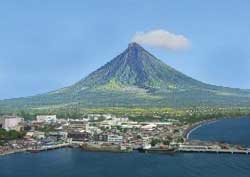Mayon Volcano
 Why the
Mayon Volcano
is special
Why the
Mayon Volcano
is specialMayon Volcano has a near-perfect cone shape, endowing it with symmetrical beauty. You can see all of its grandeur, from base to summit, because it sits alone above a vast sloping plane.
Mayon Volcano tips and insights
Mayon Volcano is still active
Almost 50 other eruptions occurred over the past 400 years. That's an average of one every eight years. The latest eruption (2013) took the lives of some climbers.
Most deadly eruption
It happened in 1814. Over 1,200 people perished. Most of them took refuge in the church in Cagsawa. Unfortunately, lava and mud flows plus airborne ash and rock fragments buried the church. Today, only the church's reclaimed bell tower bears physical testimony to the resulting tragedy. It is now a popular travel attraction.
Near-perfect shape
But Mayon is not the world's only near-perfect cone volcano. Other famous ones include Mount Fuji in Japan and Osomo in the Argentine-Chilean Lake District.
Photo op
The church bell tower offers a striking photo opportunity: The Mayon Volcano flanked by the lonely historic tower poking out of the ground.
Recent Mayon Volcano eruptions
The photo above shows the 1984 eruption. Another major one happened in August 2006. A less severe one occurred in 2013.
When to come
Visit Mayon Volcano between December and March, the heart of the dry season. Clouds can obscure the summit during the wet season.
When to climb
The clear-sky period is also the time to scale the summit (the ascent is slippery when it rains). The final stretch is not easy – underfooting can be fragile and the incline is 30 to 40 degrees.
Height
Mayon Volcano soars 2,500 meters (8,000 feet) above sea level. The summit has a white coating that some visitors think is snow. It's sulphur.
Nearest major city
Mayon Volcano is 15 kilometers (10 miles) north of Legazpi City, which is one hour by plane from Manila.


